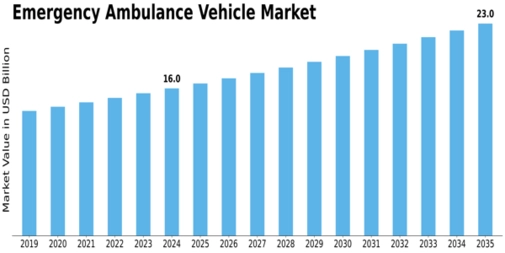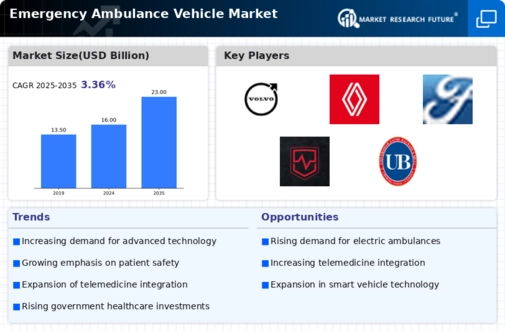-
EXECUTIVE SUMMARY
-
MARKET ATTRACTIVENESS ANALYSIS
- GLOBAL EMERGENCY AMBULANCE VEHICLE MARKET, BY APPLICATION
- GLOBAL EMERGENCY AMBULANCE VEHICLE MARKET, BY VEHICLE TYPE
- GLOBAL EMERGENCY AMBULANCE VEHICLE MARKET, BY REGION
-
MARKET INTRODUCTION
-
DEFINITION
-
SCOPE OF THE STUDY
-
MARKET STRUCTURE
-
RESEARCH METHODOLOGY
-
RESEARCH PROCESS
-
PRIMARY RESEARCH
-
SECONDARY RESEARCH
-
MARKET SIZE ESTIMATION
-
TOP-DOWN AND BOTTOM-UP APPROACHES
-
FORECAST MODEL
-
LIST OF ASSUMPTIONS & LIMITATIONS
-
MARKET DYNAMICS
-
INTRODUCTION
-
DRIVERS
- ROAD ACCIDENT DEATHS
- GROWING AGING POPULATION
- DRIVER IMPACT ANALYSIS
-
RESTRAINTS
- HIGH COST ASSOCIATED WITH THE VEHICLE
- RESTRAINT IMPACT ANALYSIS
-
OPPORTUNITY
- GROWTH IN THE HEALTHCARE INDUSTRY
-
COVID-19 IMPACT ANALYSIS
- ECONOMIC IMPACT ON AUTOMOTIVE INDUSTRY
- IMPACT ON AUTOMOTIVE PRODUCTION
- IMPACT ON EMERGENCY AMBULANCE VEHICLE MARKET
- IMPACT ON WORLD TRADE
-
MARKET FACTOR ANALYSIS
-
PORTER’S FIVE FORCES MODEL
- THREAT OF NEW ENTRANTS
- BARGAINING POWER OF SUPPLIERS
- THREAT OF SUBSTITUTES
- BARGAINING POWER OF BUYERS
- INTENSITY OF RIVALRY
-
SUPPLY CHAIN ANALYSIS
- DESIGN & DEVELOPMENT
- RAW MATERIAL/COMPONENT SUPPLY
- ASSEMBLY
- DISTRIBUTION/SUPPLY
- END USE
-
GLOBAL EMERGENCY AMBULANCE VEHICLE MARKET, BY VEHICLE TYPE
-
OVERVIEW
-
VAN
-
MOTORCYCLES
-
CARS
-
OTHERS
-
GLOBAL EMERGENCY AMBULANCE VEHICLE MARKET, BY APPLICATION
-
OVERVIEW
-
HOSPITALS
-
EMERGENCY CENTERS
-
OTHERS
-
GLOBAL EMERGENCY AMBULANCE VEHICLE MARKET, BY REGION
-
OVERVIEW
- GLOBAL EMERGENCY AMBULANCE VEHICLE MARKET, BY REGION, 2023-2032
-
EUROPE
- EUROPE: EMERGENCY AMBULANCE VEHICLE MARKET, BY COUNTRY, 2023-2032
- EUROPE: EMERGENCY AMBULANCE VEHICLE MARKET, BY VEHICLE TYPE, 2023-2032
- EUROPE: EMERGENCY AMBULANCE VEHICLE MARKET, BY APPLICATION, 2023-2032
- GERMANY
- FRANCE
- UK
- ITALY
- REST OF EUROPE
-
NORTH AMERICA
- NORTH AMERICA: EMERGENCY AMBULANCE VEHICLE MARKET, BY COUNTRY, 2023-2032
- NORTH AMERICA: EMERGENCY AMBULANCE VEHICLE MARKET, BY VEHICLE TYPE, 2023-2032
- NORTH AMERICA: EMERGENCY AMBULANCE VEHICLE MARKET, BY APPLICATION, 2023-2032
- US
- CANADA
- MEXICO
-
ASIA-PACIFIC
- ASIA-PACIFIC: EMERGENCY AMBULANCE VEHICLE MARKET, BY COUNTRY, 2023-2032 (USD MILLION)
- ASIA-PACIFIC: EMERGENCY AMBULANCE VEHICLE MARKET, BY VEHICLE TYPE, 2023-2032
- ASIA-PACIFIC: EMERGENCY AMBULANCE VEHICLE MARKET, BY APPLICATION, 2023-2032
- CHINA
- JAPAN
- INDIA
- REST OF ASIA PACIFIC
-
SOUTH AMERICA
- SOUTH AMERICA: EMERGENCY AMBULANCE VEHICLE MARKET, BY VEHICLE TYPE, 2023-2032
- SOUTH AMERICA: EMERGENCY AMBULANCE VEHICLE MARKET, BY APPLICATION, 2023-2032
-
MIDDLE EAST & AFRICA
- MIDDLE EAST & AFRICA: EMERGENCY AMBULANCE VEHICLE MARKET, BY VEHICLE TYPE, 2023-2032
- MIDDLE EAST & AFRICA: EMERGENCY AMBULANCE VEHICLE MARKET, BY APPLICATION, 2023-2032
-
COMPETITIVE LANDSCAPE
-
COMPETITIVE OVERVIEW
-
COMPETITIVE BENCHMARKING
-
MARKET SHARE ANALYSIS, 2022 (%)
-
KEY DEVELOPMENTS AND GROWTH STRATEGIES
- PRODUCT LAUNCHES/PRODUCT ENHANCEMENTS
- ACQUISITIONS & MERGERS
- PARTNERSHIPS, AGREEMENTS, AND EXPANSIONS
-
COMPANY PROFILES
-
TOYOTA MOTOR CORPORATION
- COMPANY OVERVIEW
- FINANCIAL OVERVIEW
- PRODUCTS OFFERED
- KEY DEVELOPMENTS
- SWOT ANALYSIS
- KEY STRATEGIES
-
REV GROUP
- COMPANY OVERVIEW
- FINANCIAL OVERVIEW
- PRODUCTS OFFERED
- KEY DEVELOPMENTS
- SWOT ANALYSIS
- KEY STRATEGIES
-
VOLVO
- COMPANY OVERVIEW
- FINANCIAL OVERVIEW
- PRODUCTS OFFERED
- KEY DEVELOPMENTS
- SWOT ANALYSIS
- KEY STRATEGIES
-
DAIMLER AG
- COMPANY OVERVIEW
- FINANCIAL OVERVIEW
- PRODUCTS OFFERED
- KEY DEVELOPMENTS
- SWOT ANALYSIS
- KEY STRATEGIES
-
MAN SE
- COMPANY OVERVIEW
- FINANCIAL OVERVIEW
- PRODUCTS OFFERED
- KEY DEVELOPMENTS
- SWOT ANALYSIS
- KEY STRATEGIES
-
RENAULT TRUCKS
- COMPANY OVERVIEW
- FINANCIAL OVERVIEW
- PRODUCTS OFFERED
- KEY DEVELOPMENTS
-
FORD MOTOR COMPANY
- COMPANY OVERVIEW
- FINANCIAL OVERVIEW
- PRODUCTS OFFERED
- KEY DEVELOPMENTS
-
LEADER EMERGENCY VEHICLES
- COMPANY OVERVIEW
- FINANCIAL OVERVIEW
- PRODUCTS OFFERED
- KEY DEVELOPMENTS
-
LIFELINE EMERGENCY VEHICLES
- COMPANY OVERVIEW
- FINANCIAL OVERVIEW
- PRODUCTS OFFERED
- KEY DEVELOPMENTS
-
W.A.S AMBULANCE
- COMPANY OVERVIEW
- FINANCIAL OVERVIEW
- PRODUCTS OFFERED
- KEY DEVELOPMENTS
-
BAUS AT
- COMPANY OVERVIEW
- FINANCIAL OVERVIEW
- PRODUCTS OFFERED
- KEY DEVELOPMENTS
-
-
LIST OF TABLES
-
LIST OF ASSUMPTIONS & LIMITATIONS
-
GLOBAL EMERGENCY AMBULANCE VEHICLE MARKET, BY VEHICLE TYPE, 2023-2032 (USD MILLION)
-
GLOBAL EMERGENCY AMBULANCE VEHICLE MARKET, BY APPLICATION, 2023-2032 (USD MILLION)
-
GLOBAL EMERGENCY AMBULANCE VEHICLE MARKET, BY REGION, 2023-2032 (USD MILLION)
-
EUROPE: EMERGENCY AMBULANCE VEHICLE MARKET, BY COUNTRY, 2023-2032 (USD MILLION)
-
EUROPE: EMERGENCY AMBULANCE VEHICLE MARKET, BY VEHICLE TYPE, 2023-2032 (USD MILLION)
-
EUROPE: EMERGENCY AMBULANCE VEHICLE MARKET, BY APPLICATION, 2023-2032 (USD MILLION)
-
GERMANY: EMERGENCY AMBULANCE VEHICLE MARKET, BY VEHICLE TYPE, 2023-2032 (USD MILLION)
-
GERMANY EMERGENCY AMBULANCE VEHICLE MARKET, BY APPLICATION, 2023-2032 (USD MILLION)
-
FRANCE: EMERGENCY AMBULANCE VEHICLE MARKET, BY VEHICLE TYPE, 2023-2032 (USD MILLION)
-
FRANCE EMERGENCY AMBULANCE VEHICLE MARKET, BY APPLICATION, 2023-2032 (USD MILLION)
-
UK: EMERGENCY AMBULANCE VEHICLE MARKET, BY VEHICLE TYPE, 2023-2032 (USD MILLION)
-
UK EMERGENCY AMBULANCE VEHICLE MARKET, BY APPLICATION, 2023-2032 (USD MILLION)
-
ITALY: EMERGENCY AMBULANCE VEHICLE MARKET, BY VEHICLE TYPE, 2023-2032 (USD MILLION)
-
ITALY EMERGENCY AMBULANCE VEHICLE MARKET, BY APPLICATION, 2023-2032 (USD MILLION)
-
REST OF EUROPE: EMERGENCY AMBULANCE VEHICLE MARKET, BY VEHICLE TYPE, 2023-2032 (USD MILLION)
-
REST OF EUROPE: EMERGENCY AMBULANCE VEHICLE MARKET, BY APPLICATION, 2023-2032 (USD MILLION)
-
NORTH AMERICA: EMERGENCY AMBULANCE VEHICLE MARKET, BY COUNTRY, 2023-2032 (USD MILLION)
-
NORTH AMERICA: EMERGENCY AMBULANCE VEHICLE MARKET, BY VEHICLE TYPE, 2023-2032 (USD MILLION)
-
NORTH AMERICA: EMERGENCY AMBULANCE VEHICLE MARKET, BY APPLICATION, 2023-2032 (USD MILLION)
-
US: EMERGENCY AMBULANCE VEHICLE MARKET, BY VEHICLE TYPE, 2023-2032 (USD MILLION)
-
US EMERGENCY AMBULANCE VEHICLE MARKET, BY APPLICATION, 2023-2032 (USD MILLION)
-
CANADA: EMERGENCY AMBULANCE VEHICLE MARKET, BY VEHICLE TYPE, 2023-2032 (USD MILLION)
-
CANADA EMERGENCY AMBULANCE VEHICLE MARKET, BY APPLICATION, 2023-2032 (USD MILLION)
-
MEXICO: EMERGENCY AMBULANCE VEHICLE MARKET, BY VEHICLE TYPE, 2023-2032 (USD MILLION)
-
MEXICO: EMERGENCY AMBULANCE VEHICLE MARKET, BY APPLICATION, 2023-2032 (USD MILLION)
-
ASIA-PACIFIC: EMERGENCY AMBULANCE VEHICLE MARKET, BY COUNTRY, 2023-2032 (USD MILLION)
-
ASIA-PACIFIC: EMERGENCY AMBULANCE VEHICLE MARKET, BY VEHICLE TYPE, 2023-2032 (USD MILLION)
-
ASIA-PACIFIC: EMERGENCY AMBULANCE VEHICLE MARKET, BY APPLICATION, 2023-2032 (USD MILLION)
-
CHINA: EMERGENCY AMBULANCE VEHICLE MARKET, BY VEHICLE TYPE, 2023-2032 (USD MILLION)
-
CHINA: EMERGENCY AMBULANCE VEHICLE MARKET, BY APPLICATION, 2023-2032 (USD MILLION)
-
JAPAN: EMERGENCY AMBULANCE VEHICLE MARKET, BY VEHICLE TYPE, 2023-2032 (USD MILLION)
-
JAPAN: EMERGENCY AMBULANCE VEHICLE MARKET, BY APPLICATION, 2023-2032 (USD MILLION)
-
INDIA: EMERGENCY AMBULANCE VEHICLE MARKET, BY VEHICLE TYPE, 2023-2032 (USD MILLION)
-
INDIA: EMERGENCY AMBULANCE VEHICLE MARKET, BY APPLICATION, 2023-2032 (USD MILLION)
-
REST OF ASIA-PACIFIC: EMERGENCY AMBULANCE VEHICLE MARKET, BY VEHICLE TYPE, 2023-2032 (USD MILLION)
-
REST OF ASIA-PACIFIC: EMERGENCY AMBULANCE VEHICLE MARKET, BY APPLICATION, 2023-2032 (USD MILLION)
-
SOUTH AMERICA: EMERGENCY AMBULANCE VEHICLE MARKET, BY VEHICLE TYPE, 2023-2032 (USD MILLION)
-
SOUTH AMERICA: EMERGENCY AMBULANCE VEHICLE MARKET, BY APPLICATION, 2023-2032 (USD MILLION)
-
MIDDLE EAST & AFRICA: EMERGENCY AMBULANCE VEHICLE MARKET, BY VEHICLE TYPE, 2023-2032 (USD MILLION)
-
MIDDLE EAST & AFRICA: EMERGENCY AMBULANCE VEHICLE MARKET, BY APPLICATION, 2023-2032 (USD MILLION)
-
PRODUCT LAUNCHES/PRODUCT ENHANCEMENTS
-
ACQUISITIONS & MERGERS
-
PARTNERSHIPS, AGREEMENTS, AND EXPANSIONS
-
TOYOTA MOTOR CORPORATION: PRODUCTS OFFERED
-
TOYOTA MOTOR CORPORATION: KEY DEVELOPMENTS
-
REV GROUP: PRODUCTS OFFERED
-
REV GROUP: KEY DEVELOPMENTS
-
VOLVO: PRODUCTS OFFERED
-
VOLVO: KEY DEVELOPMENTS
-
DAIMLER AG: PRODUCTS OFFERED
-
DAIMLER AG: KEY DEVELOPMENTS
-
MAN SE: PRODUCTS OFFERED
-
MAN SE: KEY DEVELOPMENTS
-
RENAULT TRUCKS: PRODUCTS OFFERED
-
RENAULT TRUCKS: KEY DEVELOPMENTS
-
FORD MOTOR COMPANY: PRODUCTS OFFERED
-
FORD MOTOR COMPANY: KEY DEVELOPMENTS
-
LEADER EMERGENCY VEHICLES: PRODUCTS OFFERED
-
LIFELINE EMERGENCY VEHICLES COMPANY: PRODUCTS OFFERED
-
W.A.S AMBULANCE: PRODUCTS OFFERED
-
W.A.S AMBULANCE: KEY DEVELOPMENTS
-
BAUS AT: PRODUCTS OFFERED
-
-
LIST OF FIGURES
-
MARKET SYNOPSIS
-
GLOBAL EMERGENCY AMBULANCE VEHICLE MARKET ANALYSIS, BY APPLICATION
-
GLOBAL EMERGENCY AMBULANCE VEHICLE MARKET ANALYSIS, BY VEHICLE TYPE
-
GLOBAL EMERGENCY AMBULANCE VEHICLE MARKET ANALYSIS, BY REGION
-
GLOBAL EMERGENCY AMBULANCE VEHICLE MARKET: MARKET STRUCTURE
-
RESEARCH PROCESS OF MRFR
-
MARKET DYNAMICS: GLOBAL EMERGENCY AMBULANCE VEHICLE MARKET
-
ROAD ACCIDENT DEATHS PER LAKH POPULATION (2019)
-
POPULATION AGES 65 AND ABOVE (% OF THE TOTAL POPULATION)
-
DRIVER IMPACT ANALYSIS: GLOBAL EMERGENCY AMBULANCE VEHICLE MARKET
-
RESTRAINT IMPACT ANALYSIS: GLOBAL EMERGENCY AMBULANCE VEHICLE MARKET
-
PORTER’S FIVE FORCES ANALYSIS: GLOBAL EMERGENCY AMBULANCE VEHICLE MARKET
-
SUPPLY CHAIN ANALYSIS: GLOBAL EMERGENCY AMBULANCE VEHICLE MARKET
-
GLOBAL EMERGENCY AMBULANCE VEHICLE MARKET, BY VEHICLE TYPE, 2022 (% SHARE)
-
GLOBAL EMERGENCY AMBULANCE VEHICLE MARKET, BY VEHICLE TYPE, 2023-2032 (USD MILLION)
-
GLOBAL EMERGENCY AMBULANCE VEHICLE MARKET, BY APPLICATION, 2022 (% SHARE)
-
GLOBAL EMERGENCY AMBULANCE VEHICLE MARKET, BY APPLICATION, 2023-2032 (USD MILLION)
-
GLOBAL EMERGENCY AMBULANCE VEHICLE MARKET, BY REGION, 2018 TO 2027 (USD MILLION)
-
GLOBAL EMERGENCY AMBULANCE VEHICLE MARKET, BY REGION, 2022 (% SHARE)
-
EUROPE: EMERGENCY AMBULANCE VEHICLE MARKET SHARE, BY COUNTRY, 2022 (% SHARE)
-
NORTH AMERICA: EMERGENCY AMBULANCE VEHICLE MARKET SHARE, BY COUNTRY, 2022 (% SHARE)
-
ASIA-PACIFIC: EMERGENCY AMBULANCE VEHICLE MARKET SHARE, BY COUNTRY, 2022 (% SHARE)
-
BENCHMARKING OF MAJOR COMPETITORS
-
TOYOTA MOTOR CORPORATION: FINANCIAL OVERVIEW SNAPSHOT
-
TOYOTA MOTOR CORPORATION: SWOT ANALYSIS
-
REV GROUP: FINANCIAL OVERVIEW SNAPSHOT
-
REV GROUP: SWOT ANALYSIS
-
VOLVO: FINANCIAL OVERVIEW SNAPSHOT
-
VOLVO: SWOT ANALYSIS
-
DAIMLER AG: FINANCIAL OVERVIEW SNAPSHOT
-
DAIMLER AG: SWOT ANALYSIS
-
MAN SE: FINANCIAL OVERVIEW SNAPSHOT
-
MAN SE: SWOT ANALYSIS
-
FORD MOTOR COMPANY: FINANCIAL OVERVIEW SNAPSHOT









Leave a Comment